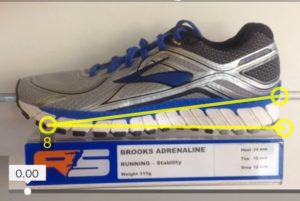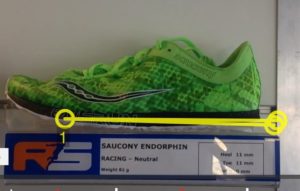
High drop – 12mm

Low drop – 0mm
Most shoes will sit between 0-12mm of drop. Above are two road shoes at opposite ends of the spectrum. The high drop shoe pictured left sits at 12mm, and the low drop sits at 0mm, completely flat heel to forefoot relationship. Then there’s everything in between.
Which drop is best? That depends……on so many things.
Who are you? What’s your current drop? Do you have any niggles/injuries? Where are they? How much are you running? How much do you want to run? How many shoes do you rotate through in a typical week? Any other goals? And more
Some hot tips:
Calf, Achilles or plantar fascia issues? A low drop may increase load on these tissues. Consider a higher drop than what you currently have.
Front of shin, knee or hip issues? Are you currently in a high drop? A lower drop may help de-load these areas.
A lot of retail stores used to exclusively stock high drop shoes. I see some runners in the Clinic in high drop shoes who are overstriding with a heavy heel strike – a high drop shoe can sometimes encourage this overstride as they rely on all that cushioning under the heel. Most of the experienced runners I see are light on their feet and don’t need a heavy or an over-protective shoe.
Are you thinking of changing drop? DO IT SLOWLY and have a backup plan.
A rapid change can lead to sudden overload. It can even change your running technique!
A common fault is too much of a change- If you own one pair of shoes; any change more than 2mm at a time is risky.
A good option is to rotate between shoes. If you currently run in an 8mm drop, before it wears out consider adding a lighter 6mm shoe for shorter runs and speed work. This could also serve as your race day shoe and can improve performance. Having more than one shoe option gives flexibility. Run in the lower drop to give your feet and calves the ability to work, strengthen and adapt to the new loads. Feeling sore? Go back to your original higher drop until your body has adapted.
I personally rotate through 4 pairs in a week. They all differ slightly, some in drop and in weight. Apart from this, I am often issuing foot and calf strength work to my patients. This can help speed up the adaptation process.
Don’t just purchase your same old favourite shoe each time. Consider variability – improve your running.
Know your drop!
Phil de Mestre
Sports Podiatrist – Running Science
